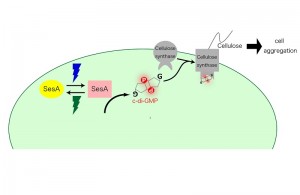Light-induced cell aggregation in cyanobacteria Novel light signaling mechanism applicable to biomass production

Cyanobacteria (blue-green algae) are a type of microalgae highly suitable for biomass production and biotechnology research. Cyanobacteria perform oxygenic photosynthesis as do plants, but in addition are equipped with advanced light receptors that sense the light essential for the photosynthetic reaction and a signal transduction mechanism to regulate intracellular processes. In particular, while it is known that cyanobacteriochromes, a diverse class of photoreceptors, are capable of detecting a wide range of light from near-ultraviolet to red light by a variety of mechanisms, in most cases their physiological roles remained unknown.

© 2014 Masahiko Ikeuchi.
A proposed signaling pathway for SesA.
Blue-light irradiation photoconverts SesA into the active form, which catalyzes the formation of c-di-GMP via its diguanylate cyclase activity. When the cellulose synthase binds c-di-GMP, it produces cellulose. Extracellular cellulose accumulation results in cell aggregation.
Here, a research group led by Masahiko Ikeuchi at the University of Tokyo’s Graduate School of Arts and Sciences Department of Multidisciplinary Sciences and including graduate student Gen Enomoto, characterized a cyanobacteriochrome, SesA. They found that 1) SesA responds to blue and green light, 2) SesA is a blue light?activated diguanylate cyclase that synthesizes a bacterial second messenger, c-di-GMP, and 3) SesA mediates blue light?induced cell aggregation which depends on the photosynthetic production of cellulose under low temperature conditions. This is the first report of this combined receptor and signal transduction mechanism.
With a deeper understanding of this signaling mechanism it may become possible to develop an efficient cell harvester method for use in photosynthetic biomass production, for example by inducing cell aggregation by irradiation with light of a particular color. This result was chosen as an outstanding paper in The Journal of Biological Chemistry, the top journal in the field of biochemistry.
Paper
Gen Enomoto, Ryouhei Nomura, Takashi Shimada, Ni-Ni Win, Rei Narikawa, and Masahiko Ikeuchi,
“Cyanobacteriochrome SesA is a diguanylate cyclase that induces cell aggregation in Thermosynechococcus”,
The Journal of Biological Chemistry Online Edition: 2014/7/24 (Japan time), doi: 10.1074/jbc.M114.583674.
Article link
Links
Graduate School of Arts and Sciences
Department of Life Sciences, Graduate School of Arts and Sciences (Japanese)
Ikeuchi Laboratory, Department of Life Sciences, Graduate School of Arts and Sciences






